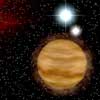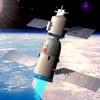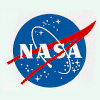|
Sunday:
January 14, 2001 | |
0429 GMT |
 |
Pulsar's companion a possible black hole?
Astronomers have found a radio pulsar with a companion at least 11 times the mass of the Sun -- the most massive pulsar companion known. The companion's identity is uncertain: it may be a massive red star, a massive but compact blue star, or possibly a black hole. If it is a black hole then this will be the first pulsar -- black hole binary system found, and a superb natural laboratory for testing general relativity.
 FULL STORY FULL STORY
 |  |

|
 |
NASA probe gives report on conditions in star nurseries
After more than two years in space, NASA's Submillimeter Wave Astronomy Satellite has provided radio astronomers with one definite conclusion about the clouds of gas and dust that make up the bulk of the mass in our galaxy, the Milky Way. "There's not much to drink there, and it's hard to breathe," says a lead scientist.
 FULL STORY FULL STORY
 |  |

|
 |
Hubble to put supernova theory to the test
In the spring of 2001, NASA's Hubble Space Telescope will catch nearby supernovae in the act of exploding at prescheduled times, the targets to be supplied "on demand" for the first time. Spectra from these nearby supernovae will be used to calibrate measurements of the accelerating expansion of the universe.
 FULL STORY FULL STORY
 |  |

|
 |
Oldest rock shows Earth a hospitable young planet
Geological evidence suggests that Earth may have had surface water -- and thus conditions to support life -- billions of years earlier than previously thought. Scientists reconstructed the portrait of early Earth by reading the telltale chemical composition of the oldest known terrestrial rock.
 FULL STORY FULL STORY
 |  |

|
 |
|
Saturday:
January 13, 2001 | |
0504 GMT |
 |
Chandra finds evidence of black hole 'event horizons'
Astronomers have used NASA's Chandra X-ray Observatory to study some of the darkest black holes yet observed. Their work strongly confirms the reality of the "event horizon," the one-way membrane around black holes predicted by Einstein's theory of relativity.
 FULL STORY FULL STORY
 |  |

|
 |
Remains of our galaxy's 'last meal' discovered
A telltale bulge in the disk of the Milky Way galaxy may be the remnants of a smaller galaxy consumed billions of years ago as our galaxy formed, astronomers announced this week. The discovery may provide scientists with new data to support -- or challenge -- existing models of how galaxies are created.
 FULL STORY FULL STORY
 |  |

|
 |
Stardust's blurry vision fixed as craft nears Earth
As NASA's Stardust comet probe barrels towards Earth for a close encounter flyby on Monday, its navigation camera appears to be working again after an apparent post-launch contamination of the device.
 FULL STORY FULL STORY
 |  |

|
 |
Newborn star offers insight into our solar system's past
Evidence that small dust grains are agglomerating into larger blocks inside a persistent shell of gas and dust around a young, nearby star is giving a team of astronomers a rare glimpse into the process that likely formed our solar system.
 FULL STORY FULL STORY
 |  |

|
 |
|
Friday:
January 12, 2001 | |
0158 GMT |
 |
Hubble finally may have proof black holes do exist
NASA's Hubble Space Telescope may have, for the first time, provided direct evidence for the existence of black holes by observing the disappearance of matter as it falls beyond the "event horizon."
 FULL STORY FULL STORY
 |  |

|
 |
Report: U.S. needs stronger defense role in space
Calling space a "top national security priority," an independent commission chaired by the nation's next Secretary of Defense concluded in a report released Thursday that the United States military needs to take a more active and better focused role in Earth orbit.
 FULL STORY FULL STORY
 |  |

|
 |
New images show detail of neighbor galaxy's gas
Using radio telescopes in the U.S. and Europe, astronomers have made the most detailed images ever of Hydrogen gas in a spiral galaxy other than the Milky Way -- the galaxy M33, known to amateur astronomers as the Pinwheel Galaxy.
 FULL STORY FULL STORY
 |  |

|
 |
Nearby galaxies yield clues to early universe
Astronomers are using these three NASA Hubble Space Telescope images to help tackle the question of why distant galaxies have such odd shapes, appearing markedly different from the typical elliptical and spiral galaxies seen in the nearby universe.
 FULL STORY FULL STORY
 |  |

|
 |
Rocket stage replacement on tap for Sea Launch Zenit
The Sea Launch vessels have set sail for home, departing the equatorial waters of the Pacific Ocean on a voyage back to the United States so a portion of the Zenit 3SL rocket can be replaced in the wake of an aborted engine ignition sequence this week.
 MISSION STATUS CENTER MISSION STATUS CENTER
 VIDEO: COUNTDOWN ABORTED VIDEO: COUNTDOWN ABORTED
 |  |

|
 |
DAILY BRIEFING Other stories making news today
|
 |
U.S. firm to build Chinese communications satellite -- Space Systems/Loral announced this week that it had received a contract from a Hong Kong-based satellite operator to build Apstar 5, a replacement for the aging Apstar 1 communications spacecraft.
|
 |
|
Thursday:
January 11, 2001 | |
0344 GMT |
 |
Chandra links pulsar to supernova of 386 AD
New evidence from NASA's Chandra X-ray Observatory suggests that a known pulsar is the present-day counterpart to a supernova that exploded in 386 AD, a stellar explosion witnessed by Chinese astronomers. If confirmed, this will be only the second known pulsar to be clearly associated with a historic event.
 FULL STORY FULL STORY
 |  |

|
 |
Extreme warp found in Andromeda's stellar disk
Astronomers have obtained new evidence of an extreme warp in the stellar disk of the Andromeda Galaxy, our nearest galactic neighbor. Possible causes of the warp include interactions between Andromeda and its smaller satellite galaxies.
 FULL STORY FULL STORY
 |  |

|
 |
Arianespace begins 2001 with launch for Turkey
A telecommunications satellite that will bridge 150 million Turkish-speaking people of Europe and Asia was launched into orbit Wednesday by an Arianespace Ariane 4 rocket, marking the European booster's 60th straight success.
 FULL STORY FULL STORY
 MISSION STATUS CENTER MISSION STATUS CENTER
 |  |

|
 |
Arianespace posts $185 million loss for 2000
Arianespace reports it lost money last year, the first time the European launch services firm's annual earnings have wound up in the red during its 20-year history. But officials say they are optimistic that mark will not be repeated in 2001 with plans to reduce operating costs.
 FULL STORY FULL STORY
 |  |

|
 |
Air Force delays launch of weather satellite for repairs
Next week's launch of a U.S. military weather satellite aboard a Titan 2 rocket from California's Vandenberg Air Force Base has been pushed back one day after technicians accidentally damaged a sun shield on the craft during pre-flight cleaning.
 FULL STORY FULL STORY
 |  |

|
 |
DAILY BRIEFING Other stories making news today
|
 |
Date set for next space shuttle launch -- NASA has established January 19 as the official launch date for space shuttle Atlantis' upcoming mission to deliver the $1.38 billion U.S. Destiny laboratory research module to the international space station.
|
 |
|
Wednesday:
January 10, 2001 | |
0507 GMT |
 |
Bizarre new planets puzzle astronomers
Astronomers Tuesday announced the discovery of a pair of new and highly unusual planetary systems that challenge their views on the structure of solar systems and even the definition of a planet.
 FULL STORY FULL STORY
 |  |

|
 |
Engine replacement delays Sea Launch to Feb. 28
Sea Launch officials Tuesday decided the first stage engine on the Zenit 3SL rocket needs to be replaced because its pre-ignition sequence was started during Monday's aborted countdown. The job will require the command ship and launching platform return to port, delaying the mission until February 28.
 MISSION STATUS CENTER MISSION STATUS CENTER
 VIDEO: COUNTDOWN ABORTED VIDEO: COUNTDOWN ABORTED
 |  |

|
 |
'Pipeline' funnels matter between colliding galaxies
This visible-light picture, taken by NASA's Hubble Space Telescope, reveals an intergalactic "pipeline" of material flowing between two battered galaxies that bumped into each other about 100 million years ago.
 FULL STORY FULL STORY
 |  |

|
 |
Winds postpone Ariane 4 rocket launch yet again
Continued unacceptable winds above the jungle launch site in Kourou, French Guiana has forced Arianespace to forego making an attempt Tuesday night to fly the Ariane 4 rocket with the Eurasiasat 1 satellite. Launch has been reset for Wednesday.
 MISSION STATUS CENTER - updated MISSION STATUS CENTER - updated
 |  |

|
 |
Over 150 rapidly moving stars found in Milky Way
Astronomers have discovered 154 rapidly moving stars towards the center of our galaxy and our brightest neighboring galaxy. The results are of special interest because this is the first time scientists have been able to discover such objects in front of the millions of stars seen at the Galactic center and the Large Magellanic Cloud.
 FULL STORY FULL STORY
 |  |

|
 |
DAILY BRIEFING Other stories making news today
|
 |
Boeing begins building Navy communications satellite -- Boeing has received the final go-ahead to manufacture an eleventh satellite for the U.S. Navy's UHF Follow-On communications satellite constellation, keeping the network working well into this decade to relay spy satellite photos, intelligence reports and strike orders to U.S. troops around the world.
|
 |
|
Tuesday:
January 9, 2001 | |
2100 GMT |
 |
Chinese capsule launched on second unmanned test
China took another step towards manned space travel today by launching its second prototype capsule on a demonstration flight. The unmanned Shenzhou 2 spacecraft, with several animals aboard, was successfully launched into the planned orbit around Earth by a Long March rocket on a several-day excursion.
 FULL STORY FULL STORY
 |  |

|
 |
Chandra reveals the X-ray glint in the Cat's Eye nebula
Scientists have discovered a glowing bubble of hot gas and an unexpected X-ray bright central star within the planetary nebula known as the Cat's Eye using NASA's Chandra X-ray Observatory. The new results provide insight into the ways that stars like our Sun end their lives.
 FULL STORY FULL STORY
 |  |

|
 |
Sea Launch aborts liftoff in final seconds of countdown
A last-moment concern with the XM 1 radio broadcasting satellite cargo led to a frantic halt to the countdown of Sea Launch's Zenit 3SL rocket on Monday with clocks stopping 11 seconds before blastoff from the Odyssey platform in the equatorial Pacific Ocean.
 MISSION STATUS CENTER MISSION STATUS CENTER
 VIDEO: COUNTDOWN ABORTED VIDEO: COUNTDOWN ABORTED
 |  |

|
 |
Arianespace Ariane 4 rocket launch delayed to Tuesday
Gusty high altitude winds above the jungle launch site in Kourou, French Guiana forced Arianespace to scrub Monday's planned liftoff of an Ariane 4 rocket carrying the Eurasiasat 1 telecommunications satellite. Officials are hoping for improved conditions Tuesday.
 MISSION STATUS CENTER MISSION STATUS CENTER
 |  |

|
 |
Astronomers map largest structure in distant universe
By reading the light from the fiery heart of unimaginably remote galaxies, astronomers have discovered evidence for an immense concentration of galaxies over 6.5 billion light years away in the largest known group of quasars, possibly the largest structure anywhere in the observable universe.
 FULL STORY FULL STORY
 |  |

|
 |
Rare spherical nebula helps measure stars' composition
The simple spherical geometry of the beautiful planetary nebula Abell 39 will help astronomers identify the source of very serious errors in measuring the chemical composition of dying stars.
 FULL STORY FULL STORY
 |  |

|
 |
Evidence presented for new supernova explosion model
New research, based on observations of a brilliant supernova, is challenging existing models of how one type of the powerful explosions take place in the Universe.
 FULL STORY FULL STORY
 |  |

|
 |
|
Monday:
January 8, 2001 | |
0341 GMT |
 |
10 additional moons discovered around Jupiter
An unprecedented surge in planetary moon discoveries continues as astronomers announced Friday the discovery of 10 more moons orbiting Jupiter. The ten natural satellites were first spotted in late November and early December by a group of astronomers at the University of Hawaii.
 FULL STORY FULL STORY
 |  |

|
 |
Arianespace Ariane 4 to rocket into 2001
If an Ariane 4 rocket launches on time Monday it will have the distinction as planet Earth's first space flight of 2001. And if the European launcher can deliver its Turkish communications satellite cargo into the correct orbit it will mark the workhorse Ariane 4's 60th consecutive success. We will have complete coverage!
 MISSION STATUS CENTER MISSION STATUS CENTER
 |  |

|
 |
Sea Launch to loft first XM radio satellite today
The three-stage Ukrainian-Russian Zenit 3SL rocket was rolled from its hangar and erected atop the Odyssey launch platform Sunday as the countdown ticked away for Monday's scheduled 2235 GMT (5:35 p.m. EST) blastoff. We will have live coverage of the launch as the first XM Satellite Radio craft is boosted to orbit!
 MISSION STATUS CENTER MISSION STATUS CENTER
 ANIMATION OF XM 1 SATELLITE ANIMATION OF XM 1 SATELLITE
 |  |

|
 |
NASA's core policy over last decade gets closer look
A team of NASA officials not long ago completed a thorough review of the space agency's "faster, better, cheaper" (FBC) policy. The 83-page report highlights recommendations for where these policies and programs should be headed and how to improve them enough to get them there.
 FULL STORY FULL STORY
 |  |

|
 |


 The Hubble Space Telescope's majestic view of the Eskimo Nebula. This spectacular poster is available now from the Astronomy Now Store.
The Hubble Space Telescope's majestic view of the Eskimo Nebula. This spectacular poster is available now from the Astronomy Now Store.